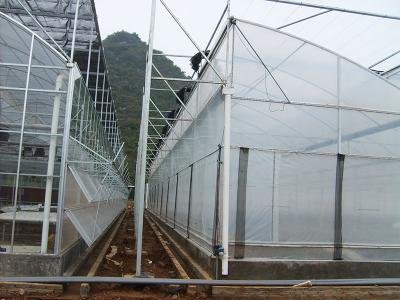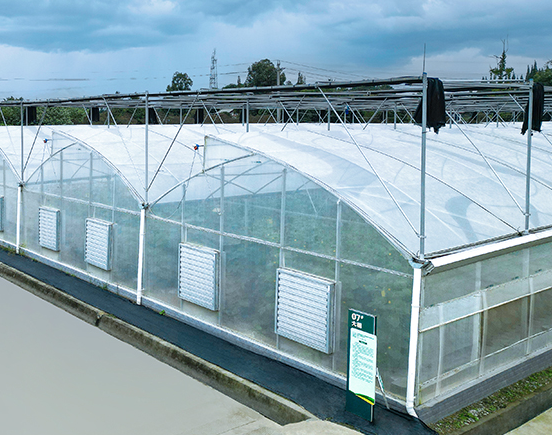Ever wondered why some greenhouses look like giant, upside-down saw blades? It’s not just for looks – it’s the design genius behind the sawtooth greenhouse. If you’re in the agricultural industry or are simply interested in innovative farming solutions, you’re in the right place. This post will dive into the design, benefits, and advantages of sawtooth greenhouses, and how they might be the game-changer your operation needs.

Introduction:
Sawtooth greenhouses offer a unique design that maximizes light, ventilation, and energy efficiency. In this blog post, we explore the benefits of this innovative greenhouse style.
What is a Sawtooth Greenhouse?
A sawtooth greenhouse is a type of greenhouse that gets its name from its distinctive roof design, which resembles the teeth of a saw. This design is made up of a series of alternating, slanted panels that allow for better ventilation, natural light distribution, and more effective climate control. Unlike traditional greenhouses, which tend to have flat roofs, the sawtooth structure offers a higher roof profile, which is ideal for managing both airflow and sunlight.
The sawtooth structure features a series of glass or polycarbonate panels, where the “teeth” or peaks face one direction, and the valleys are angled in the opposite direction. This not only enhances the greenhouse’s ventilation system but also helps regulate temperature and humidity – key factors when cultivating delicate plants like cannabis, flowers, or vegetables.
This type of greenhouse design has been around for decades, and its effectiveness in improving energy efficiency and plant growth has made it a popular choice among commercial growers. Sawtooth greenhouses can be found all over the world, with applications in horticulture, agriculture, and even urban farming initiatives.

Why Should You Consider a Sawtooth Greenhouse?
Well, you might be asking, “Why not just use a traditional greenhouse?” The truth is, sawtooth greenhouses offer several distinct advantages that can significantly enhance your growing operations:
- Natural Light Optimization
The angled roof design allows for optimal sunlight throughout the day, especially in regions with variable sunlight. By adjusting the orientation of the roof panels, you can maximize light exposure in winter and minimize overheating in summer. - Enhanced Ventilation
Ventilation is crucial for regulating temperature and humidity. The sawtooth design naturally promotes air circulation, allowing for better airflow throughout the structure. This leads to reduced risks of mold, mildew, and other humidity-related issues that can plague traditional greenhouses. - Improved Temperature Control
The increased ventilation also means better temperature regulation, ensuring that your plants thrive in a more stable and predictable environment. When you’re growing high-value crops like cannabis or rare flowers, this control can be the difference between a good harvest and a poor one. - Energy Efficiency
If you’re looking to reduce your energy consumption, the sawtooth greenhouse design can help. With its efficient use of natural light and ventilation, you can reduce the need for artificial lighting, fans, and HVAC systems, cutting down on energy costs. - Durability and Longevity
Most sawtooth greenhouses are built with high-quality materials like polycarbonate panels or tempered glass, making them durable and long-lasting. The design is inherently robust, offering better resistance to weather extremes like heavy snow or strong winds compared to traditional greenhouses.

How Does a Sawtooth Greenhouse Work?
Let’s break down how this structure works to maintain the perfect growing environment for your plants.
- Light Distribution: The alternating ridges and valleys of the sawtooth roof direct natural light into the greenhouse at optimal angles. This minimizes the need for artificial lighting, reducing electricity costs.
- Ventilation and Cooling: The peaks of the sawtooth roof allow for hot air to escape, while the valleys provide openings for fresh air to enter, creating a constant flow of air. This natural ventilation system helps cool the greenhouse, especially during hot summer months.
- Energy Efficiency: With natural heating and cooling, the sawtooth greenhouse minimizes the need for external energy sources, helping you save on heating, cooling, and ventilation costs.
Benefits of Sawtooth Greenhouses vs. Traditional Greenhouses
If you’re still on the fence, let’s take a closer look at how sawtooth greenhouses stack up against more conventional structures. Here’s a quick comparison:
| Feature | Sawtooth Greenhouse | Traditional Greenhouse |
|---|---|---|
| Ventilation | Excellent, due to the peaked roof design | May require mechanical ventilation systems |
| Light Distribution | Optimal throughout the day | May require supplemental lighting |
| Temperature Control | Great natural temperature regulation | Less efficient without added HVAC systems |
| Energy Efficiency | Low energy use, as natural light and airflow are maximized | May need more energy for lighting and cooling |
| Durability | Strong and weather-resistant | Can be more susceptible to harsh weather |
| Initial Cost | Higher due to more complex design | Generally more affordable initially |
Is a Sawtooth Greenhouse Right for You?
It all depends on your growing needs and the type of crops you’re cultivating. If you’re a commercial grower or have specific needs such as growing cannabis or high-value vegetables, the investment in a sawtooth greenhouse can pay off in the long run due to enhanced yield, energy savings, and better plant health.
If you want to explore further, we recommend reading more about greenhouse technologies on sites like this one for additional insights on greenhouse designs.
More Questions About Sawtooth Greenhouses?
Here are a few other commonly asked questions:
1. How long do sawtooth greenhouses last?
Sawtooth greenhouses, especially those made with polycarbonate or tempered glass, are built to last for decades with proper maintenance. You can expect them to last 20+ years with minimal repairs.
2. Can I use a sawtooth greenhouse in colder climates?
Yes, the sawtooth design is beneficial in colder climates as it provides excellent insulation while maintaining airflow. Adding photovoltaic panels can further enhance energy efficiency.
3. Are sawtooth greenhouses more expensive?
The initial cost can be higher than traditional greenhouses, but the long-term savings on energy and better plant yields often make them a cost-effective option.
Conclusion
A sawtooth greenhouse is more than just a pretty design – it’s an engineering marvel that can improve plant growth, reduce energy consumption, and optimize the growing environment. Whether you’re a grower focused on cannabis, flowers, or vegetables, the sawtooth greenhouse is a smart choice for maximizing efficiency and ensuring a healthier harvest. If you’re ready to upgrade your greenhouse, this design might just be the solution you’ve been looking for.

